Seriously. I want to smell like hot ghee for the rest of my life. It’s a marriage of straight-out-of-the-oven shortbread and Parmesan.
So anyway, what’s this gheelicious stuff?
The Ancients in Ayurvedic teachings (them ones with sagacity and sexperience) considered ghee to be the most sacred of foods as it enabled the “goodness” from our diet to be absorbed. Scientists can now tell us why. Ghee, a sister of butter, is rich in fat-soluble vitamins A and D, without which some nutrients like calcium cannot be synthesised in the body.
Interesting, eh?
Yes, it’s still saturated fat but this doesn’t bother me.
What interests me most is its nutritional whistle, and its stability when heated in a frying pan. As soon as any fat reaches its ‘smoke point’, the point at which the fat begins to decompose and make free radicals, the fat will lose any nutritional purchase it once had. Free radicals are those nasty carcinogenic compounds that act like evil Power Rangers in our system. Not the sort of thing you want to serve your family.
Extra Virgin olive oil has a ‘smoke point’ of 180C, so anything higher will disfigure the fat and mutilate its nutritional profile.
Similarly, hemp oil has a low smoke point of 160C, and will fox trot with your arteries if heated any higher (this one is awesome for salad dressings, so keep it away from the pan).
What do I use? Coconut oil, with a boastful smoke point of 220C. But ghee is sneaking into Irish kitchens, without the threat of yogi pantaloons. It has a smoke point of around 220C.
Why not just use butter? I hear you! The milk solids (proteins and natural sugars) bring butter’s smoke point down to 150C. In the process of making ghee, these milk solids including lactose and casein are removed, leaving only liquid gold and a house smelling of freshly baked shortbread. This markedly raises its smoke point. Ghee whizz.
This might help explain why so many dairy-intolerants are dandy with ghee.
Making Ghee
You can find ghee in Middle Eastern stores or health food shops across Ireland. But you can also make it in your own kitchen today! It’s easier than boiling pasta.
Irish ghee is the best in the world, don’t you know?
500g block of unsalted Irish butter
50g patience
Ideally, use a small heavy-based saucepan. Bring the butter to a gentle putter on a low to medium flame. Let it burp and rumble for 20-30 minutes.
During this time, expect a queer foam to coat the top. Just scoop this off and throw away. We are interested in the next layer – the liquid gold. After 20 minutes, the lighter-coloured milk solids will drop to the bottom of the saucepan, underneath the layer of fabulously golden butterfat.
Watch carefully. When the smell of freshly baked parmesany shortbread cookies fills the air, it’s done. You’ll also notice the milk solids changing colour on the bottom. Remove from the flame.
I use scrupulously clean jam jars, and line each one with muslin or cheesecloth. Pour the now-clarified butter into each jar, straining first through the muslin cloth. This will catch the milk solids, which in turn will prevent the ghee spoiling.
Leave to cool at room temperature before storing in the fridge.
Expect ghee to last for up to 1 year in the fridge, or 12 weeks at room temperature. Your frying pan’s new BF.

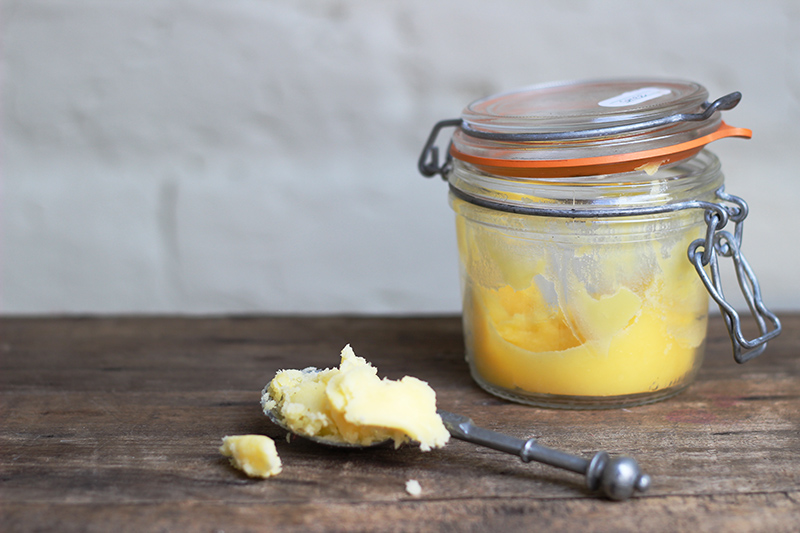
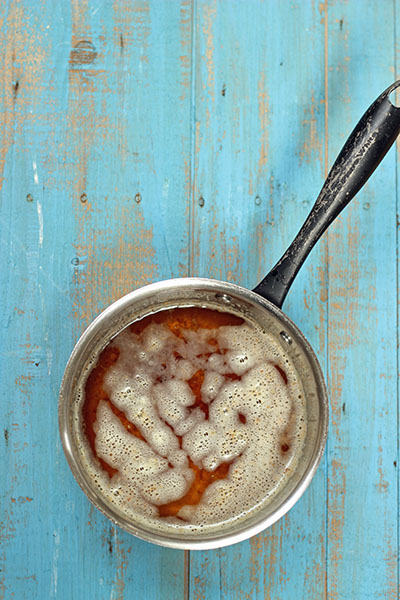

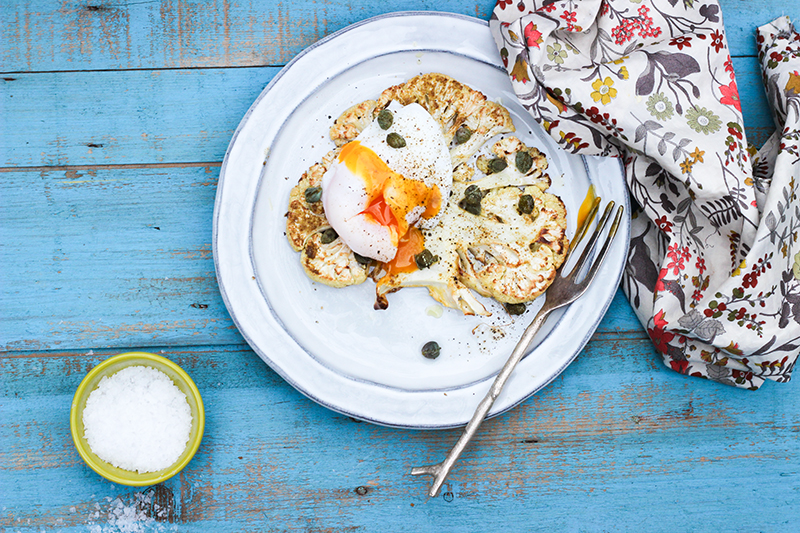
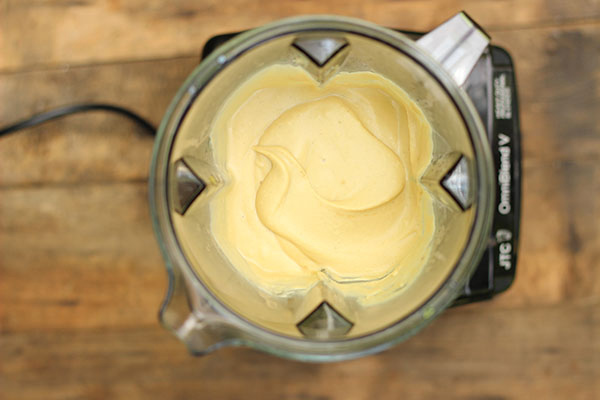
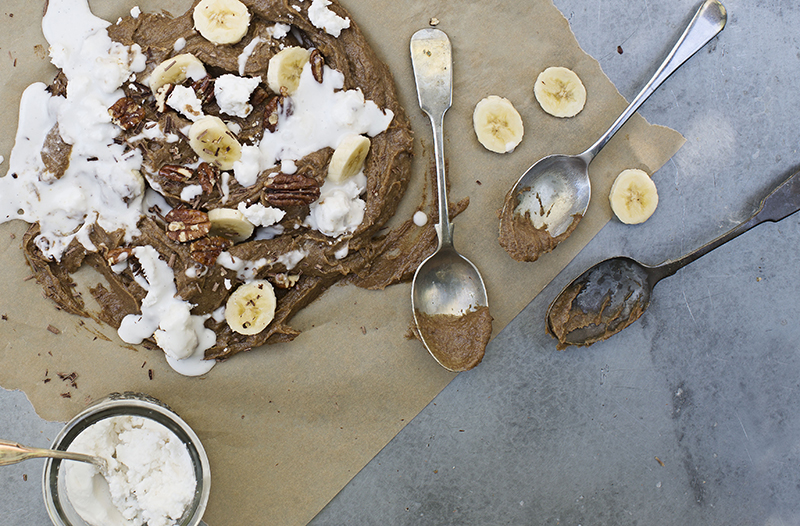
8 Comments
Hi Susan,
Your book helped me when I first started this delicious lifestyle 🙂 I was wondering what brand of extra virgin olive oil you use i am looking for a good brand preferably not costing the bank 🙂 Thanks
Hi Sharon, Thanks! I change my brand all the time. It’s good to go for different cold-pressed EV variety each time you buy. Lidl do a good one in a glass bottle that doesn’t cost the earth 😉 Otherwise, I go for small producers from Italy, usually organic but not always. Hope this helps! Good luck!!
Thanks I will check out Lidl & the likes 🙂
Their almonds not so great, but their other foiled nuts are superb
I love your book and your work…fabulous. I’m a bit confused about the ghee.I’m amazed it can be made at home. excellent. So you line the jars with muslin , fill the jars and then pull out the muzlin to take the solids out of the jar? Can the solids be used for anything?
Many Thanks,
Maeve.
Hi Maeve – Darina Allen eats the solids on toast! I chuck them (not good for composting though). Hope this helps. Ghee is spectacular. Good luck! SJ
[…] ghee or butter 200g dark chocolate 3 eggs 100ml malted barley 100g coconut, rapadura or muscavado sugar […]
[…] heat a non-stick frying pan over a medium to high heat with your preferred fat (we love ghee, which has a naturally high smoking point). Drop in a little batter about the size of a scone, and […]